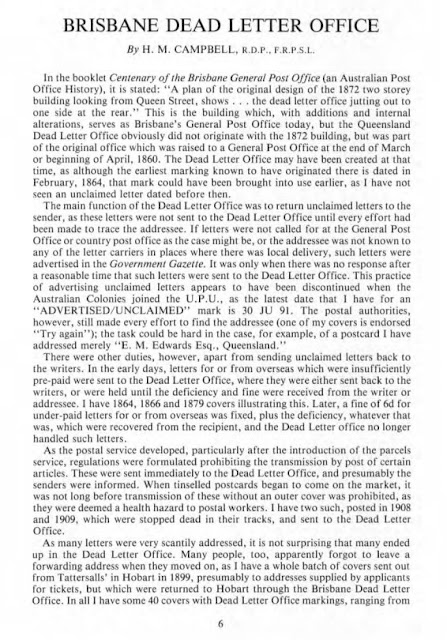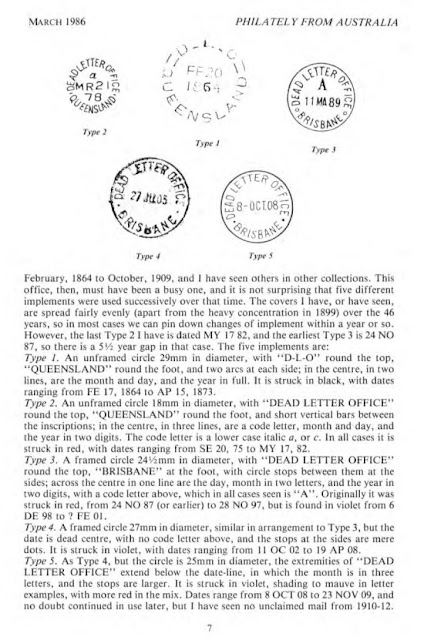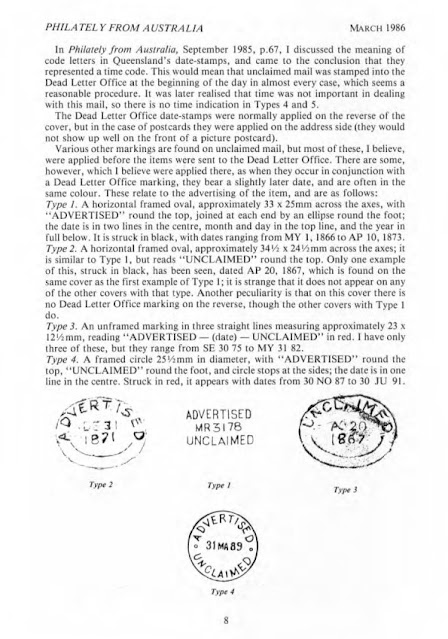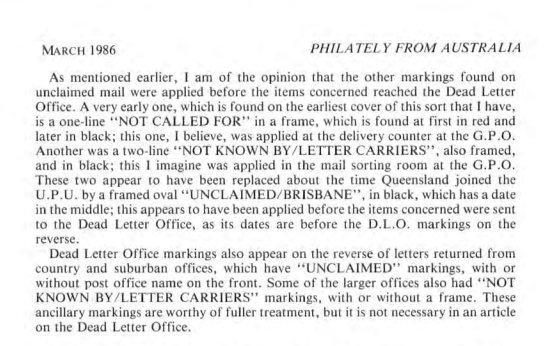A fascinating article on the Brisbane Dead Letter Office by H M Campbell published in Philately from Australia in March 1986. For more and updated information on the implements used there see my Brisbane stamp blog HERE




BRISBANE DEAD LETTER OFFICE
By H. M. CAMPBELL, R.D.P., F.R.P.S.L.
In the booklet Centenary of the Brisbane General Post Office
(an Australian Post Office History), it is stated: "A plan of the original
design of the 1872 two storey building looking from Queen Street, shows... the
dead letter office jutting out to one side at the rear." This is the
building which, with additions and internal alterations, serves as Brisbane's
General Post Office today, but the Queensland Dead Letter Office obviously did
not originate with the 1872 building, but was part of the original office which
was raised to a General Post Office at the end of March or beginning of April,
1860. The Dead Letter Office may have been created at that time, as although
the earliest marking known to have originated there is dated in February, 1864,
that mark could have been brought into use earlier, as I have not seen an
unclaimed letter dated before then.
The main function of the Dead Letter Office was to return
unclaimed letters to the sender, as these letters were not sent to the Dead
Letter Office until every effort had been made to trace the addressee. If
letters were not called for at the General Post Office or country post office
as the case might be, or the addressee was not known to any of the letter
carriers in places where there was local delivery, such letters were advertised
in the Government Gazette. It was only when there was no response after a
reasonable time that such letters were sent to the Dead Letter Office. This
practice. of advertising unclaimed letters appears to have been discontinued when
the Australian Colonies joined the U.P.U., as the latest date that I have for
an "ADVERTISED/UNCLAIMED" mark is 30 JU 91. The postal authorities,
however, still made every effort to find the addressee (one of my covers is
endorsed "Try again"); the task could be hard in the case, for
example, of a postcard I have addressed merely "E. M. Edwards Esq.,
Queensland."
There were other duties, however, apart from sending
unclaimed letters back to the writers. In the early days, letters for or from
overseas which were insufficiently pre-paid were sent to the Dead Letter
Office, where they were either sent back to the writers, or were held until the
deficiency and fine were received from the writer or addressee. I have 1864,
1866 and 1879 covers illustrating this. Later, a fine of 6d for under-paid
letters for or from overseas was fixed, plus the deficiency, whatever that was,
which were recovered from the recipient, and the Dead Letter office no longer
handled such letters.
As the postal service developed, particularly after the
introduction of the parcels service, regulations were formulated prohibiting
the transmission by post of certain articles. These were sent immediately to
the Dead Letter Office, and presumably the senders were informed. When
tinselled postcards began to come on the market, it was not long before
transmission of these without an outer cover was prohibited, as they were
deemed a health hazard to postal workers. I have two such, posted in 1908 and
1909, which were stopped dead in their tracks, and sent to the Dead Letter
Office.
As many letters were very scantily addressed, it is not
surprising that many ended up in the Dead Letter Office. Many people, too,
apparently forgot to leave at forwarding address when they moved on, as I have
a whole batch of covers sent out from Tattersalls' in Hobart in 1899,
presumably to addresses supplied by applicants for tickets, but which were
returned to Hobart through the Brisbane Dead Letter Office. In all I have some
40 covers with Dead Letter Office markings, ranging from February, 1864 to October, 1909, and I have seen others in other
collections. This office, then, must have been a busy one, and it is not
surprising that five different implements were used successively over that
time. The covers I have, or have seen, are spread fairly evenly (apart from the
heavy concentration in 1899) over the 46. years, so in most cases we can pin
down changes of implement within a year or so. However, the last Type 2 1 have
is dated MY 17 82, and the earliest Type 3 is 24 NO 87, so there is a 5½ year
gap in that case. The five implements are:

Type 1. An unframed circle 29mm in diameter, with
"D-L-O" round the top, "QUEENSLAND" round the foot, and two
arcs at each side; in the centre, in two lines, are the month and day, and the
year in full. It is struck in black, with dates ranging from FE 17, 1864 to AP
15, 1873.
Type 2. An unframed circle 18mm in diameter, with "DEAD
LETTER OFFICE" round the top, "QUEENSLAND" round the foot, and
short vertical bars between the inscriptions; in the centre, in three lines,
are a code letter, month and day, and the year in two digits. The code letter
is a lower case italic a, or c. In all cases it is struck in red, with dates ranging from SE 20, 75 to MY 17,
82. Type 3. A framed circle 24mm in diameter, with "DEAD LETTER
OFFICE" round the top, "BRISBANE" at the foot, with circle stops
between them at the sides; across the centre in one line are the day, month in
two letters, and the year in two digits, with a code letter above, which in all
cases seen is "A". Originally it was struck in red, from 24 NO 87 (or
earlier) to 28 NO 97, but is found in violet from 6 DE 98 to 7 FE 01. Type 4. A framed circle 27mm in diameter,
similar in arrangement to Type 3, but the date is dead centre, with no code
letter above, and the stops at the sides are mere dots. It is struck in violet,
with dates ranging from 11 OC 02 to 19 AP 08.
Type 3. As Type 4, but the circle is 25mm in diameter, the
extremities of "DEAD LETTER OFFICE" extend below the date-line, in
which the month is in three letters, and the stops are larger. It is struck in
violet, shading to mauve in letter examples, with more red in the mix. Dates
range from 8 OCT 08 to 23 NOV 09, and no doubt continued in use later, but I
have seen no unclaimed mail from 1910-12.
In Philately from Australia, September 1985, p.67, I
discussed the meaning of code letters in Queensland's date-stamps, and came to
the conclusion that they represented a time code. This would mean that
unclaimed mail was stamped into the Dead Letter Office at the beginning of the
day in almost every case, which seems a reasonable procedure. It was later
realised that time was not important in dealing with this mail, so there is no
time indication in Types 4 and 5.
The Dead Letter Office date-stamps were normally applied on
the reverse of the cover, but in the case of postcards they were applied on the
address side (they would not show up well on the front of a picture postcard).
Various other markings are found on unclaimed mail, but most
of these, I believe, were applied before the items were sent to the Dead Letter
Office. There are some, however, which I believe were applied there, as when
they occur in conjunction with a Dead Letter Office marking, they bear a
slightly later date, and are often in the same colour. These relate to the
advertising of the item, and are as follows: Type 1. A horizontal framed oval,
approximately 33 x 25mm across the axes, with "ADVERTISED" round the
top, joined at each end by an ellipse round the foot; the date is in two lines
in the centre, month and day in the top line, and the year in full below. It is
struck in black, with dates ranging from MY 1, 1866 to AP 10, 1873. Type 2. A
horizontal framed oval, approximately 34½ x 24½mm across the axes; it is
similar to Type 1, but reads "UNCLAIMED" round the top. Only one
example of this, struck in black, has been seen, dated AP 20, 1867, which is
found on the same cover as the first example of Type 1; it is strange that it
does not appear on any of the other covers with that type. Another peculiarity
is that on this cover there is no Dead Letter Office marking on the reverse,
though the other covers with Type 1 do.
Type 3. An unframed marking in three straight lines
measuring approximately 23 x 12mm, reading "ADVERTISED (date)- UNCLAIMED"
in red. I have only three of these, but they range from SE 30 75 to MY 31 82.
Type 4. A framed circle 25mm in diameter, with "ADVERTISED" round the
top, "UNCLAIMED" round the foot, and circle stops at the sides; the
date is in one line in the centre. Struck in red, it appears with dates from 30
NO 87 to 30 JU 91.

As mentioned earlier, I am of the opinion that the other
markings found on unclaimed mail were applied before the items concerned
reached the Dead Letter Office. A very early one, which is found on the
earliest cover of this sort that I have, is a one-line "NOT CALLED
FOR" in a frame, which is found at first in red and later in black; this
one, I believe, was applied at the delivery counter at the G.P.O. Another was a
two-line "NOT KNOWN BY/LETTER CARRIERS", also framed, and in black;
this I imagine was applied in the mail sorting room at the G.P.O. These two appear
to have been replaced about the time Queensland joined the U.P.U. by a framed
oval "UNCLAIMED/BRISBANE", in black, which has a date in the middle;
this appears to have been applied before the items concerned were sent to the
Dead Letter Office, as its dates are before the D.L.O. markings on the reverse.
Dead Letter Office markings also appear on the reverse of
letters returned from country and suburban offices, which have
"UNCLAIMED" markings, with or without post office name on the front.
Some of the larger offices also had "NOT KNOWN BY/LETTER CARRIERS"
markings, with or without a frame. These ancillary markings are worthy of
fuller treatment, but it is not necessary in an article on the Dead Letter
Office.
September 1986 Update
There are one or two things in the article which need correcting. On page 7, the last word in the third-last line should read 'later', not 'letter'. Something went wrong with the captions for the illustrations at the bottom of page 8: 'Type 2' should be Type 1', 'Type I' should be 'Type 3', and 'Type 3' should be 'Type 2'.
In the first paragraph on page 9, I give the impression that Brisbane's 'NOT KNOWN BY/LETTER CARRIERS' was superseded by the oval UN- CLAIMED/BRISBANE'. This, however, is misleading, as the former remained in contemporaneous use. I have an 1899 postcard from England with both, and a 1909 postcard from New Zealand with the 'NOT KNOWN... marking.





